
Econimics of fashion
- 1. Economics Of The Fashion Industry Can an infant fashion industry become a major player in the global fashion industry?
- 2. Thesis Question “Can an ‘infant’ fashion industry overcome the established advantages in current fashion capitals and become a major player in the global industry?”
- 3. Objective By performing a comparative analysis of the growth and profitability of companies, the thesis highlights the success prospects of an upcoming fashion company which is relatively new to the market and/or not based in one of the 4 major fashion clusters, and analyses the scope of it emerging as a major player in the global fashion industry. In addition, a special emphasis is given on the operations of the companies in the ongoing COVID-19 pandemic and their future business scope. Thus, the conclusions of our thesis will help aspiring entrepreneurs and designers to make an informed decision about their business prospects and success strategies.
- 4. WHAT IS FASHION? Fashion is a term that is plagued by its many different interpretations. Most commonly, fashion alludes to the prevailing style of dressing or behaviour at any given time that is spread across a population, with the strong implication that it is characterized by change. Today, fashion has become one of the primary ways in which people express their personalities and their own unique taste and styling. The fashion industry encompasses a network of global enterprises that involves the design, manufacturing and selling of apparel and accessories.
- 5. CLOTHING FASHION INDUSTRY Although the fashion industry refers to a myriad of industries, the thesis focuses on the clothing fashion industry. The thesis aims to compare and analyse the top clothing brands in the market by taking into account the multiple categories of clothing fashion. Of all the different categories of clothing production, the thesis attempts to study three categories, namely, luxury or designer fashion, athleisure or sportswear, and fast fashion.
- 6. Historical Background Late 16th century Europe. The pace of change picked up in the 1780s with increased publication of French engravings illustrating the latest Paris styles, followed by fashion magazines. 20th Century ‘Golden Age of French fashion’ saw a radical change and reformation in fashion. Couture houses, like Chanel and Balenciaga, were established in Paris. After World War II Many couture houses in Paris had closed and the fashion scene shifted from Paris to London and New York. 19th century Charles Frederick Worth became the first fashion designer of the world in 1858.
- 7. During the late 20th century, famous fashion labels like Gucci, Prada and Louis Vuitton emerged and anticipated the globalization of world markets. Milan, benefiting from certain features of its productive structure, eventually emerged as a major trend setter, marking the beginning of the Milan Fashion Week (1958). Designers in Paris and Milan eventually began producing “ready-to-wear” fashion to keep up with New York and London. This was followed by an incredibly crucial part of the global fashion market, the Paris Fashion Week in 1973 and the prestigious London Fashion Week in 1984. Cont.
- 8. The “BIG 4” of the Fashion Industry PARIS NEW YORK LONDON MILAN
- 9. ▪ Refers to the cost advantage experienced by a firm when it increases its level of output. ▪ There are two types of economies of scale, internal and external. Internal economies refer to economies that are unique to a firm. ▪ External economies of scale include the benefits of positive externalities enjoyed by firms as a result of the development of an industry or the whole economy. ▪ “Clusters” encompass an array of linked industries and other entities important to competition. ▪ The prospect of external economies of scale often induces firms in the same industry to cluster together wherein new firms can take advantage of the existing infrastructure. ▪ With respect to the fashion industry, companies tend to congregate in the 4 major fashion clusters of the world namely, London, Paris, New York and Milan. Economies of Scale Cluster Economies
- 10. EMERGING FASHION INDUSTRIES Burgeoning fashion industries have been established in multiple cities around the globe. Studies have been conducted on the successes and failures of the emerging fashion industries of Sweden, Canada, Ghana, Uganda, Singapore, South Africa, India and various U.S cities. While some new industries, like in Sweden and Los Angeles, ▪ shown successes ▪ pointing towards their individual business strategy and a pattern of clustering similar to that of the current fashion capitals, Other industries, like Canada, ▪ lacking in their contributions to the global fashion industry ▪ due to lack of policy, support, and unification of the industry. Sweden L.A. Canada India Ghana Uganda Singapore South Africa